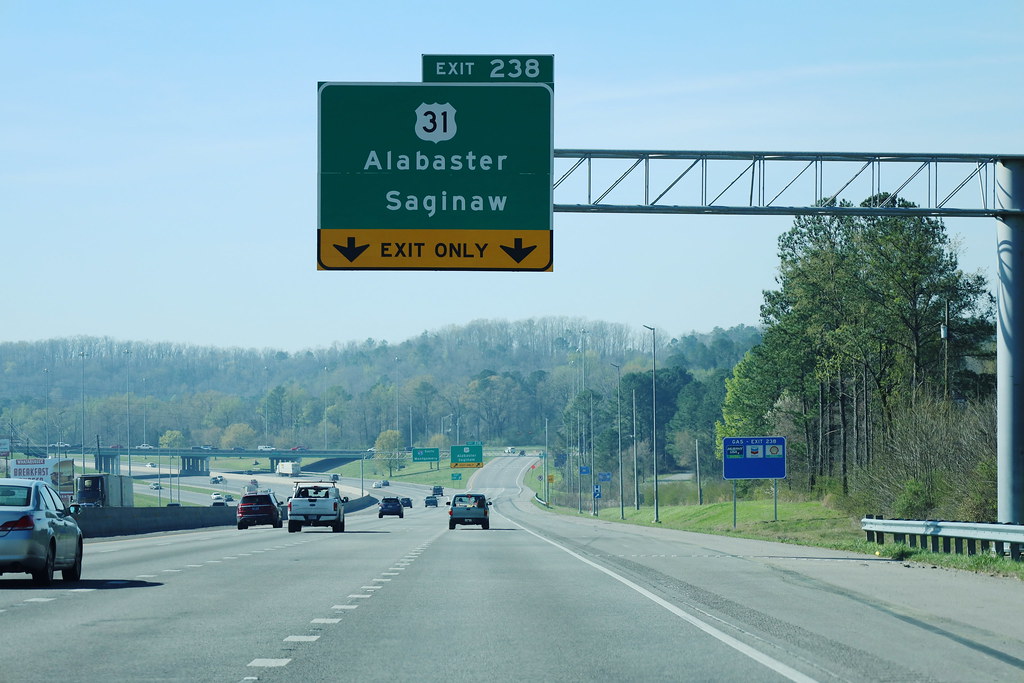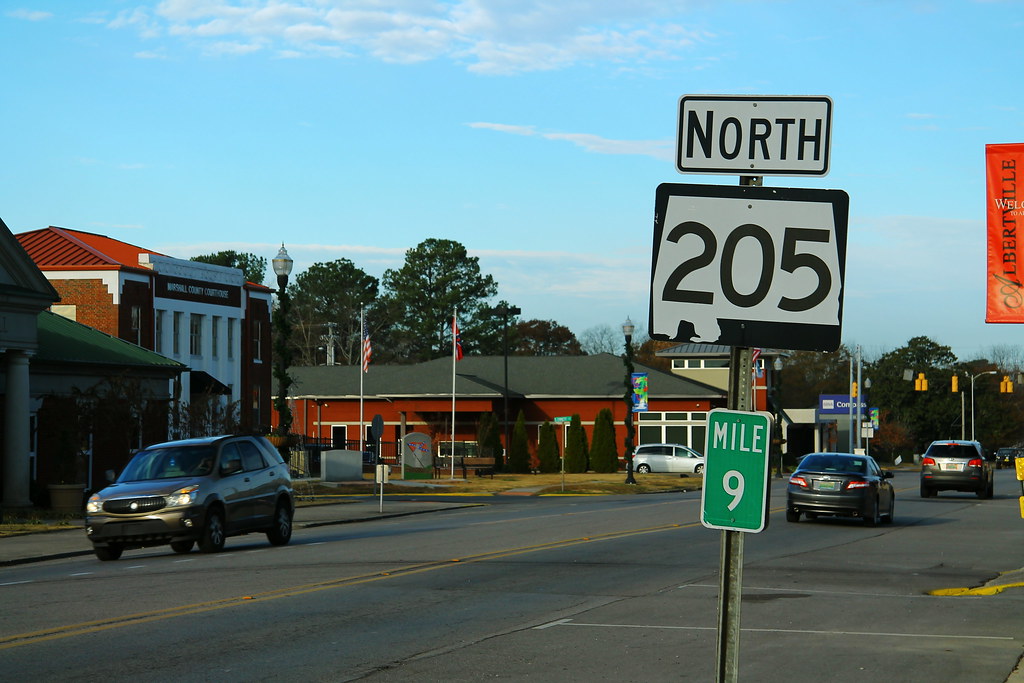Alabama is a state located in the southeastern region of the United States, known for its rich history, diverse culture, and stunning natural beauty. The state is home to several major cities, including Birmingham, Montgomery, Mobile, Huntsville, Tuscaloosa, and Auburn, each with its own unique character and charm.
To help navigate this beautiful state, we have created a comprehensive map of Alabama with cities and highways. This map provides an overview of the state’s geography, highlighting its major cities and highway system, making it an essential tool for anyone looking to explore Alabama.
Whether you’re a resident or a visitor, this map will help you discover all that Alabama has to offer, from its bustling cities to its picturesque countryside. So, grab your map and get ready to explore the Heart of Dixie!
Printable Alabama Map With Cities and Highways
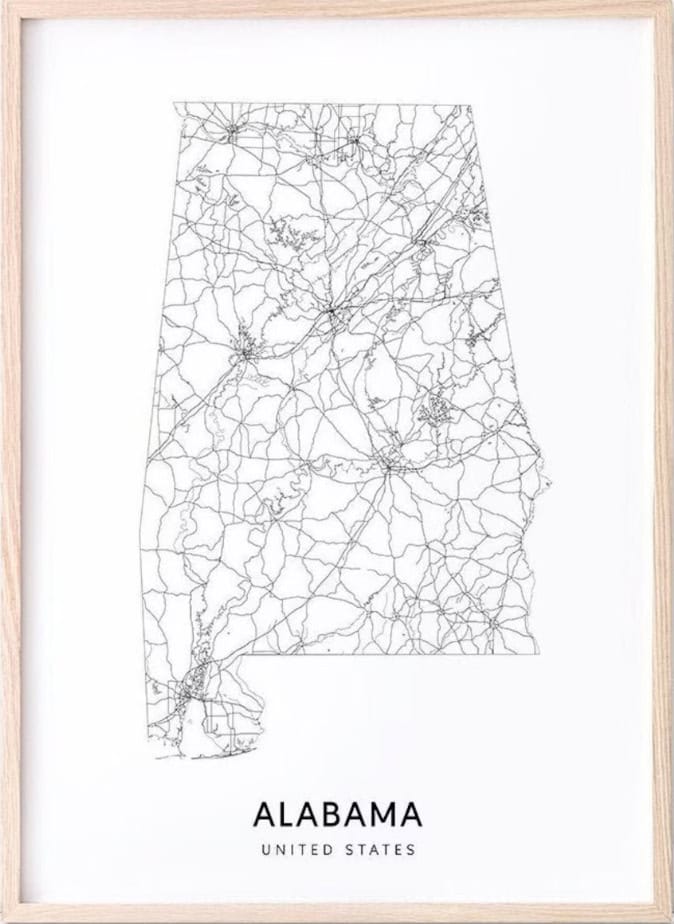
Cities
Alabaster
Alabaster is a vibrant city located in Shelby County, Alabama, United States. With a population of approximately 33,000 residents, the city is known for its strong school system, low crime rate, and community events, such as the annual Alabaster CityFest.
The city is home to several parks and recreational areas, including Veterans Park and Buck Creek Trail, which offers hiking and biking trails. Alabaster is also home to several shopping centers, restaurants, and businesses, making it a hub for commerce and entertainment in the region.
Albertville
Albertville is a charming city located in Marshall County, Alabama, United States. With a population of approximately 21,000 residents, the city is known for its rich history and diverse community.
The city is home to several parks and recreational areas, including the popular Albertville Recreation Complex, which offers a variety of sports fields and a community pool. Albertville is also known for its annual Main Street Music Festival, which attracts visitors from all over the region. The city is home to several local businesses and restaurants, making it a great destination for shopping and dining.
Alexander City
View this post on Instagram
Alexander City, also known as “Alex City,” is the largest city in Tallapoosa County, Alabama, with a population of 14,843 as of the 2020 census. The city has been the largest community in Tallapoosa County since 1910.
Alexander City is known for Lake Martin, which features 750 miles of wooded shoreline and 44,000 acres of water. The lake, located on the Tallapoosa River, offers a variety of recreational activities such as boating, swimming, fishing, golfing, and camping. Many neighborhoods and luxury homes are located on the lake, making it a popular destination for both tourists and residents. While the city’s economy was traditionally based on the textile industry, in recent times, its economic base has become more diversified as textile jobs have gone to India.
Anniston
Anniston is the county seat of Calhoun County in Alabama and is one of two principal cities included in the Anniston-Oxford Metropolitan Statistical Area. As of the 2010 census, the population of the city was 23,106, and according to 2019 Census estimates, the city had a population of 21,287.
The city is situated on the slope of Blue Mountain and was named “The Model City” by Atlanta newspaperman Henry W. Grady for its careful planning in the late 19th century. Anniston has a rich history and is home to several notable landmarks, including the Anniston Museum of Natural History and the Berman Museum of World History. The city is also known for its outdoor recreational opportunities, with Cheaha State Park and the Talladega National Forest located nearby.
Athens
Athens is a city located in Limestone County, Alabama, and serves as the county seat. The city is included in the Huntsville-Decatur-Albertville, AL Combined Statistical Area. As of the 2020 census, the population of the city is 25,406. Athens has a rich history, with several historic landmarks and attractions, including the Athens State University Historic District, which is listed on the National Register of Historic Places.
The city is also home to several parks, including the Athens Sportsplex, which features baseball fields, soccer fields, and a skate park. Additionally, the city hosts several events throughout the year, such as the Athens Grease Festival, which celebrates the city’s Greek heritage, and the Athens Storytelling Festival, which features nationally recognized storytellers.
Auburn
Auburn is a city located in Lee County, Alabama, and is the largest city in eastern Alabama. The population of the city was 76,143 as of the 2020 census. Auburn is a principal city of the Auburn-Opelika Metropolitan Area, which has a population of 193,773. The greater Columbus-Auburn-Opelika, GA-AL CSA, which includes Columbus, GA-AL MSA, and Tuskegee, Alabama, is home to 503,124 residents.
Auburn is a historic college town and is the home of Auburn University. The city has been recognized as one of the best places to live in the United States by U.S. News, ranking among its top ten list in 2009. The city’s unofficial nickname is “The Loveliest Village on the Plains,” taken from a line in the poem The Deserted Village by Oliver Goldsmith: “Sweet Auburn! Loveliest village of the plain…” Auburn’s vibrant community, rich history, and strong economy make it a desirable place to live and work.
Bessemer

Bessemer is a suburban city located in Jefferson County, Alabama, and is situated southwest of Birmingham. The city has a population of 26,019 as of the 2020 census and is part of the Birmingham-Hoover, AL Metropolitan Statistical Area, of which Jefferson County is the center. Bessemer has a rich history as an industrial city that developed rapidly in the late 19th and early 20th centuries. The city’s economy was largely based on the steel industry, and it was home to several steel mills that employed thousands of workers.
Today, Bessemer’s economy has diversified, with a focus on healthcare, education, and retail. The city is home to several parks and recreational areas, including the Bessemer Recreation Center and the Bessemer Rail Trail, a popular destination for hiking and biking. Bessemer’s historic downtown area is also undergoing revitalization efforts, with the goal of preserving its rich history while attracting new businesses and residents to the area.
Birmingham

Birmingham is a city located in the north-central region of the state of Alabama and is the seat of Jefferson County, the state’s most populous county. As of the 2022 census estimates, Birmingham had a population of 196,910, making it Alabama’s third-most populous city after Huntsville and Montgomery. The broader Birmingham metropolitan area had a 2020 population of 1,115,289, making it the largest metropolitan area in Alabama as well as the 50th-most populous in the United States.
Birmingham is a regional hub and is associated with the Deep South, Piedmont, and Appalachian regions of the nation. The city was founded in 1871 through the merger of three pre-existing farm towns, and it grew into an industrial and railroad transportation center with a focus on mining, the iron and steel industry, and railroading.
Birmingham was named after Birmingham, England, and many of its original settlers were of English ancestry. The city played a significant role in the post-Civil War Reconstruction period and was planned as a place where cheap, non-unionized, and often African-American labor from rural Alabama could be employed in the city’s steel mills and blast furnaces, giving it a competitive advantage over industrial cities in the Midwest and Northeast.
Cullman

Cullman is the largest city and county seat of Cullman County, Alabama, and is located along Interstate 65, approximately 50 miles north of Birmingham and 55 miles south of Huntsville. The city has a population of 14,775 as of the 2010 census, with an estimated population of 18,213 in 2020.
Cullman has a rich history and is home to several landmarks, including the Ave Maria Grotto, a miniature village built by a Benedictine monk, and the Cullman County Museum, which features exhibits on the history of the area. The city is also known for its annual Oktoberfest celebration, which draws visitors from across the region. Cullman’s location along Interstate 65 makes it a convenient stop for travelers, and the city’s strong economy is supported by a diverse range of industries, including healthcare, manufacturing, and retail.
Daphne

Daphne is a city located in Baldwin County, Alabama, on the eastern shoreline of Mobile Bay. The city is situated along I-10, 11 miles east of Mobile and 170 miles southwest of the state capital of Montgomery. As of the 2010 United States Census, the population of the city was 21,570, making it the most populous city in Baldwin County.
Daphne is a principal city of the Daphne-Fairhope-Foley metropolitan area, which includes all of Baldwin County. The area has a rich history, with evidence of Native American tribes dating back to the Paleo-Indian period around 9000 BC.
Today, Daphne is a thriving suburb of nearby Mobile and has adopted the nickname “The Jubilee City” in recognition of its status as one of the locations of the Mobile Bay Jubilee. The Jubilee is a natural phenomenon where fish and other sea creatures are pushed to the surface, making them easy to catch, and it only occurs in two places in the world, Mobile Bay and Tokyo Bay. Daphne’s location along the shores of Mobile Bay and its strong economy make it a desirable place to live and work.
Decatur

Decatur is the largest city and county seat of Morgan County, with a portion also in Limestone County, in the U.S. state of Alabama. The city is nicknamed “The River City” and is located in northern Alabama on the banks of Wheeler Lake, along the Tennessee River. The population of Decatur was 57,938 as of the 2020 census. Decatur is the core city of the two-county large Decatur metropolitan area, which had an estimated population of 156,494 in 2020.
The city was a hub for travelers and cargo between Nashville and Mobile, as well as Chattanooga and New Orleans, due to its location along a river and railroad routes in the early 19th century. Decatur rapidly grew into a large economic center within the Tennessee Valley and experienced steady growth throughout the 20th century.
However, it was eclipsed as the regional economic center by the fast-growing Huntsville during the space race. Decatur’s economy is now heavily based on manufacturing, mining, cargo transit, chemical, and high-tech companies such as Vulcan Materials, Daikin, Toray, and United Launch Alliance.
Dothan
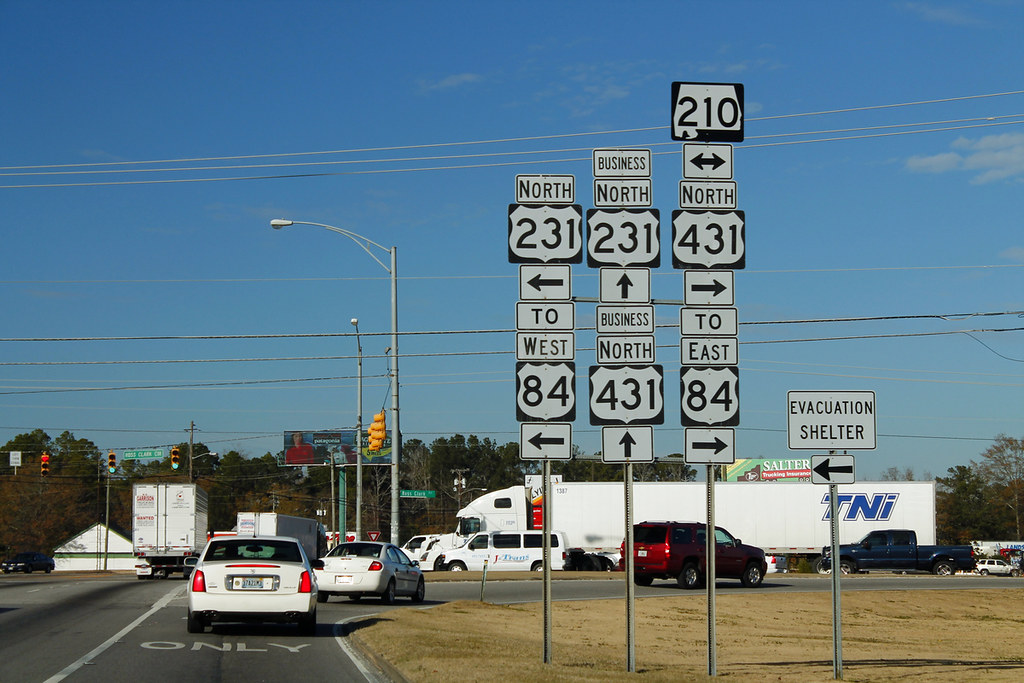
Dothan is a city located in Houston County, with a slight portion extending into Dale and Henry counties, in the U.S. state of Alabama. It is named after the biblical city where Joseph’s brothers threw him into a cistern and sold him into slavery in Egypt. Dothan is Alabama’s eighth-largest city, with a population of 71,072 as of the 2020 census, and the 5th largest in Alabama by total area.
The city is located near the state’s southeastern corner, about 20 miles west of Georgia and 16 miles north of Florida. Dothan is the principal city of the Dothan, Alabama metropolitan area, which encompasses all of Geneva, Henry, and Houston counties, and is part of the Dothan-Ozark Combined Statistical Area. The city is the main transportation and commercial hub for a significant part of southeastern Alabama, southwest Georgia, and nearby portions of the Florida Panhandle.
Dothan is known as “The Peanut Capital of the World” since approximately one-fourth of the U.S. peanut crop is produced nearby, much of it processed in the city. The city also hosts the annual National Peanut Festival at the Peanut Festival Fairgrounds.
Enterprise

Enterprise is a city located in the southeastern part of Coffee County and the southwestern part of Dale County in Southeastern Alabama, United States. Its population was 28,711 as of the 2020 census. Enterprise is the primary city of the Enterprise micropolitan statistical area, with the portion of the city in Dale County being part of the Ozark micropolitan statistical area. The city was originally part of the Enterprise-Ozark micropolitan area before being split.
Enterprise is famous for the Boll Weevil Monument, a large statue of a woman holding a boll weevil, in the middle of Main Street. The city erected the statue because the destruction of the cotton crop by the boll weevil had led to agricultural diversity, starting with peanuts and more prosperity than had ever come from cotton alone. It is the only statue of an insect pest in the world. Enterprise is located right outside the U.S. Army’s Fort Rucker, the home of Army Aviation, and is home to Enterprise State Community College.
Fairhope

Fairhope is a city located on the eastern shoreline of Mobile Bay in Baldwin County, Alabama. The population of the city was 22,477 as of the 2020 Census. Fairhope is a principal city of the Daphne-Fairhope-Foley metropolitan area, which includes all of Baldwin County. The city is known for its picturesque downtown area, which is home to many locally-owned shops, restaurants, and art galleries.
Fairhope is also home to several parks and public beaches, including the Fairhope Municipal Pier and Beach, which offers stunning views of Mobile Bay. The city hosts several annual events, including the Fairhope Arts and Crafts Festival, which attracts thousands of visitors each year. With its beautiful location and charming downtown area, Fairhope is a popular destination for tourists and a desirable place to live for residents of Baldwin County.
Florence

Florence is a city located in the northwestern corner of Alabama and is the county seat of Lauderdale County. The city is situated along the Tennessee River and is home to the University of North Alabama. Florence is the largest and principal city of the Quad Cities, also known as “The Shoals,” which includes the cities of Muscle Shoals, Sheffield, and Tuscumbia in Colbert County.
Florence is considered northwestern Alabama’s primary economic hub and is the most populous city of the 30 places in the United States with the name Florence. The city hosts several annual tourism events, including the W. C. Handy Music Festival in the summer and the Renaissance Faire in the fall. Florence is also home to several landmarks, including the Rosenbaum House, the only Frank Lloyd Wright-designed home located in Alabama, and the Florence Indian Mound, the largest surviving earthen mound in the state, which is listed on the National Register of Historic Places. The city operates under a mayor-council system of municipal government.
Gadsden

Gadsden is a city located in Etowah County, Alabama, and is the county seat. The city is situated on the Coosa River, approximately 56 miles northeast of Birmingham and 90 miles southwest of Chattanooga, Tennessee. Gadsden is the primary city of the Gadsden Metropolitan Statistical Area, which has a population of 103,931. As of the 2020 census, the population of the city was 33,945.
In the 19th century, Gadsden was Alabama’s second-most important center of commerce and industry, trailing only the seaport of Mobile. The two cities were important shipping centers, with Gadsden serving riverboats and Mobile serving international trade. From the late 19th century through the 1980s, Gadsden was a center of heavy industry, including the Goodyear Tire and Rubber Company and Republic Steel. Despite the decline in industry during the 1990s, Gadsden was awarded the honor of All-America City by the National Civic League in 1991.
Hoover
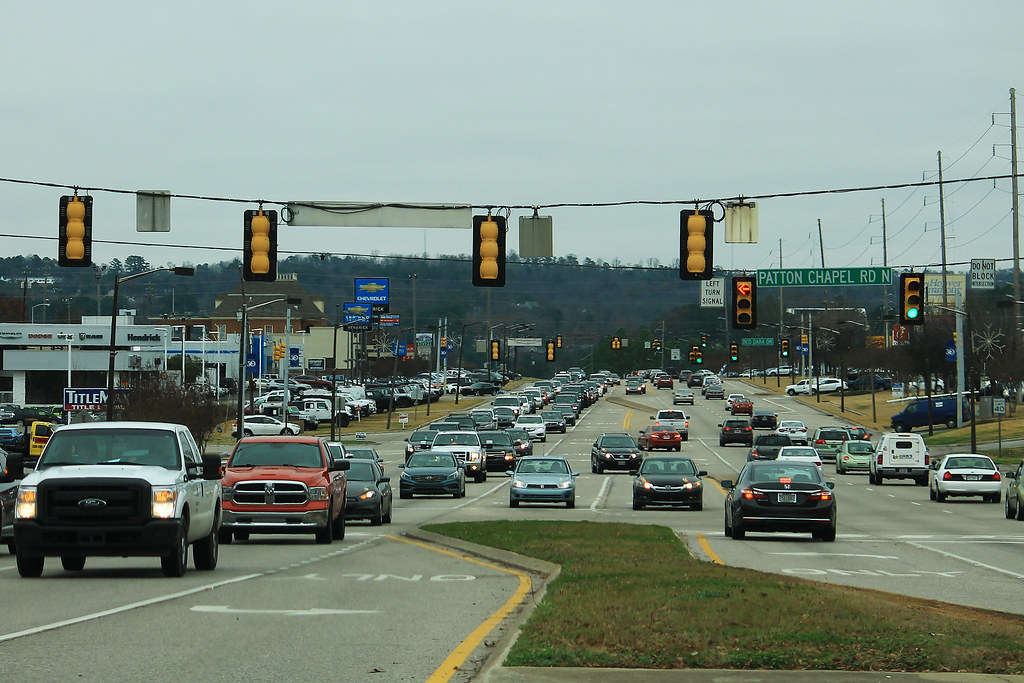
Hoover is a city located in Jefferson and Shelby counties in north central Alabama. It is the largest suburban city in Alabama and the 6th largest city in the state, with a population of 92,606 as of the 2020 US Census. Hoover is part of the Birmingham, AL Metropolitan Statistical Area and is also included in the Birmingham-Cullman-Talladega, AL Combined Statistical Area. The city’s territory is situated along the foothills of the Appalachian Mountains.
The Birmingham Barons Minor League Baseball team, which traces its history to 1885, played its home games at the 10,800-seat Hoover Metropolitan Stadium until 2013 when it moved to Regions Field in the Parkside District of Birmingham. Despite the team’s departure, Hoover Metropolitan Stadium remains a popular venue for concerts, festivals, and other events.
Huntsville

Huntsville is a city located in Madison County and Limestone County, Alabama, with a small portion extending into Morgan County. It is the county seat of Madison County and the most populous city proper in the state. Huntsville was founded in 1805 within the Mississippi Territory and became an incorporated town in 1811. When Alabama was admitted as a state in 1819, Huntsville was designated as the first capital for a year before it was moved to more central settlements.
The city developed across nearby hills north of the Tennessee River, adding textile mills in the late nineteenth century. Its major growth took place since World War II, when the U.S. Army established Redstone Arsenal in the vicinity with a chemical weapons plant and related facilities. After the war, additional research was conducted at Redstone Arsenal on rockets, followed by adaptations for space exploration.
Huntsville is now home to NASA’s Marshall Space Flight Center, the United States Army Aviation and Missile Command, and most recently the FBI’s operational support headquarters, all located at Redstone Arsenal. The city’s population was 215,006 as of the 2020 census, and the Huntsville metropolitan area’s population was 491,723 in 2020, making it the second most populous metropolitan area in the state after the Birmingham metropolitan area.
Madison
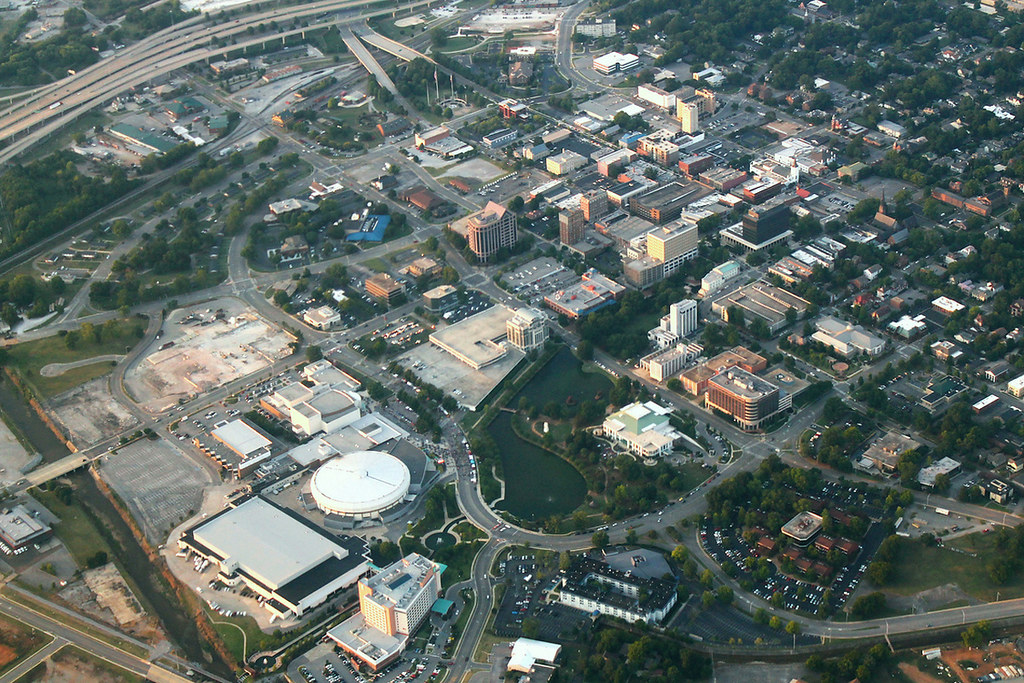
Madison is a city located primarily in Madison County, near the northern border of Alabama, with a small portion extending into Limestone County. The city is included in the Huntsville Metropolitan Area, the second-largest in the state, and is also part of the merged Huntsville-Decatur Combined Statistical Area. As of the 2020 census, the population of the city was 56,933, an increase from 42,938 in 2010.
Madison is bordered by Huntsville on nearly all sides, with some small unincorporated lands within and around Madison in Madison and Limestone counties. For many years, Madison was mostly a small city, with a population of around 400-500 for much of its history until the establishment of the Redstone Arsenal to the southeast, which attracted many people to the area for jobs. This rapidly increased the city’s population and stimulated economic growth.
Many of Madison’s residents work in Research Park or the Redstone Arsenal. As a result, Madison has been one of the fastest-growing and wealthiest cities in Alabama. In 2021 census estimates, Madison was the 9th largest city in Alabama and the second largest city in North Alabama, trailing only nearby Huntsville.
Mobile
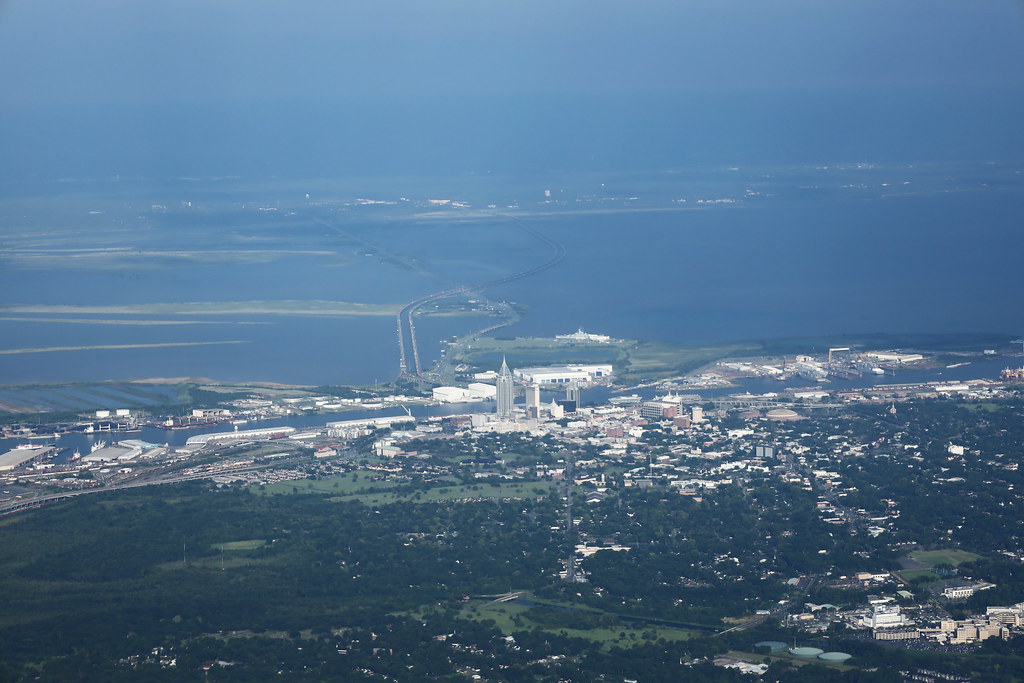
Mobile is a city located in Mobile County, Alabama, and is the county seat. The population within the city limits was 187,041 as of the 2020 census, down from 195,111 in 2010. However, after a successful vote to annex areas west of the city limits in July 2023, Mobile’s population increased to 204,689 residents, making it the second-most-populous city in Alabama after Huntsville.
Mobile is Alabama’s only saltwater port and is located on the Mobile River at the head of Mobile Bay on the north-central Gulf Coast. The Port of Mobile has always played a key role in the economic health of the city, beginning with its settlement as an important trading center between French colonists and Native Americans, down to its current role as the 12th-largest port in the United States.
Mobile is the principal municipality of the Mobile metropolitan area, which has a population of 430,197 residents and is composed of Mobile and Washington counties. The Mobile metropolitan area is the third-largest metropolitan statistical area in the state. Mobile is also the largest city in the Mobile–Daphne−Fairhope Combined Statistical Area, with a total population of 661,964, the second largest such area fully in the state.
Montgomery

Montgomery is the capital city of Alabama and the county seat of Montgomery County. It was named after Continental Army Major General Richard Montgomery and stands beside the Alabama River, on the coastal Plain of the Gulf of Mexico. As of the 2020 census, Montgomery’s population was 200,603, making it the second most populous city in Alabama after Huntsville and the 119th most populous city in the United States. The Montgomery Metropolitan Statistical Area’s population in 2020 was 386,047, making it the fourth largest in the state and 142nd among United States metropolitan areas.
The city was incorporated in 1819 as a merger of two towns situated along the Alabama River. It became the state capital in 1846, representing the shift of power to the south-central area of Alabama with the growth of cotton as a commodity crop of the Black Belt and the rise of Mobile as a mercantile port on the Gulf Coast.
In February 1861, Montgomery was chosen as the first capital of the Confederate States of America, which it remained until the Confederate seat of government moved to Richmond, Virginia, in May of that year. In the middle of the 20th century, Montgomery was a major center of events and protests in the Civil Rights Movement, including the Montgomery bus boycott and the Selma to Montgomery marches.
Mountain Brook

Mountain Brook is a city located in southeastern Jefferson County, Alabama, and is considered a suburb of Birmingham. As of the 2020 census, the population of Mountain Brook was 22,461. The city is known for its affluent neighborhoods and is one of the wealthiest cities in Alabama.
Mountain Brook is a popular residential area for professionals and families due to its proximity to Birmingham and its award-winning school system. The city also offers a variety of outdoor recreational activities, including hiking trails, parks, and golf courses. With its charming neighborhoods, excellent schools, and convenient location, Mountain Brook is a highly desirable place to live for those seeking a high quality of life in the Birmingham metropolitan area.
Northport
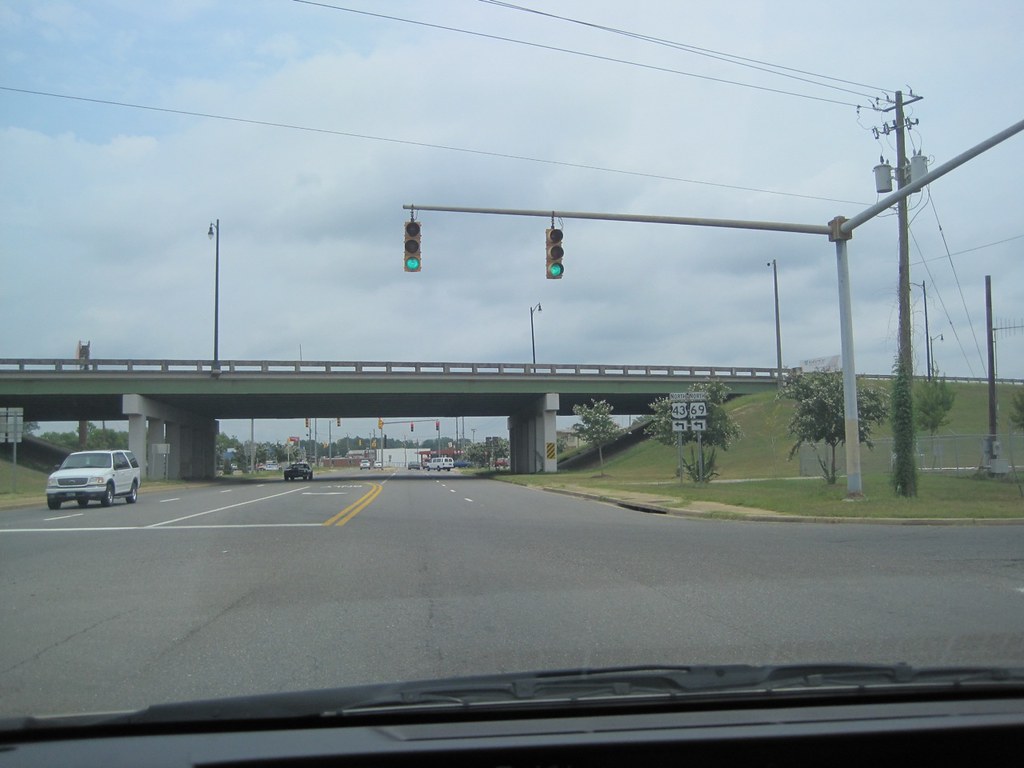
Northport is a city located in Tuscaloosa County in the west central part of Alabama. It is situated on the Black Warrior River across from downtown Tuscaloosa and is currently the 17th largest city in Alabama with a population of 31,125 according to the 2020 US Census. The city was incorporated in 1871 and is part of the Tuscaloosa Metropolitan Statistical Area.
Northport is known for its small-town charm and its close proximity to the University of Alabama in nearby Tuscaloosa. The city offers a variety of recreational opportunities, including parks, trails, and a community center. Northport is also home to many local businesses and restaurants, making it a vibrant and thriving community. With its scenic riverfront location and strong sense of community, Northport is a great place to live and work in the heart of Alabama.
Opelika
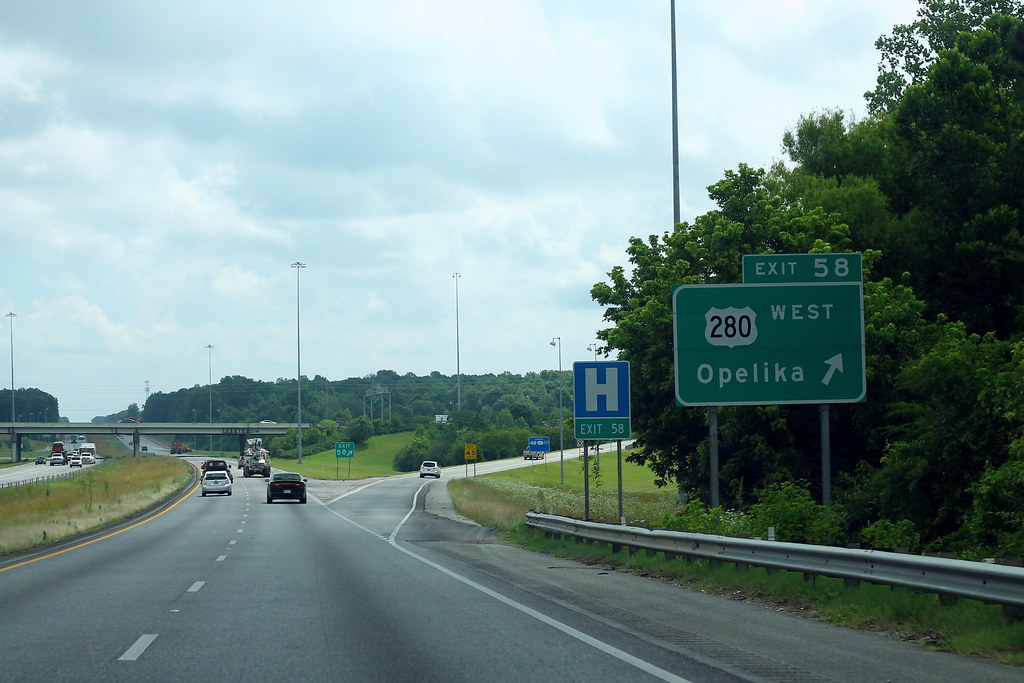
Opelika is a city located in the east-central part of Alabama and is the county seat of Lee County. It is a principal city of the Auburn-Opelika Metropolitan Area. As of the 2020 census, the population of Opelika was 30,995, representing an increase of 17.1 percent from the 2010 Census where the population was 26,477. The Auburn-Opelika, AL Metropolitan Statistical Area has a population of 150,933, and when combined with the Columbus, Georgia metropolitan area, it comprises the Greater Columbus combined statistical area, a region home to 501,649 residents.
Opelika is known for its rich history and is home to several historic districts, including the Northside Historic District and the Southside Historic District. The city also offers a variety of recreational opportunities, including parks, trails, and golf courses. With its close proximity to Auburn University and its vibrant downtown area, Opelika is a great place to live, work, and play in the heart of Alabama.
Oxford

Oxford is a city located in Calhoun, Talladega, and Cleburne counties in the State of Alabama. As of the 2020 census, the population of Oxford was 22,069. Oxford is one of two principal cities of and included in the Anniston-Oxford Metropolitan Statistical Area, and it is the largest city in Calhoun County by population.
The city is known for its strong sense of community and its commitment to education, offering a number of top-rated schools. Oxford is also home to a variety of recreational opportunities, including parks, trails, and golf courses. The city’s downtown area features a number of locally-owned businesses and restaurants, making it a vibrant and thriving community. With its convenient location and high quality of life, Oxford is a great place to live, work, and play in the heart of Alabama.
Pelham
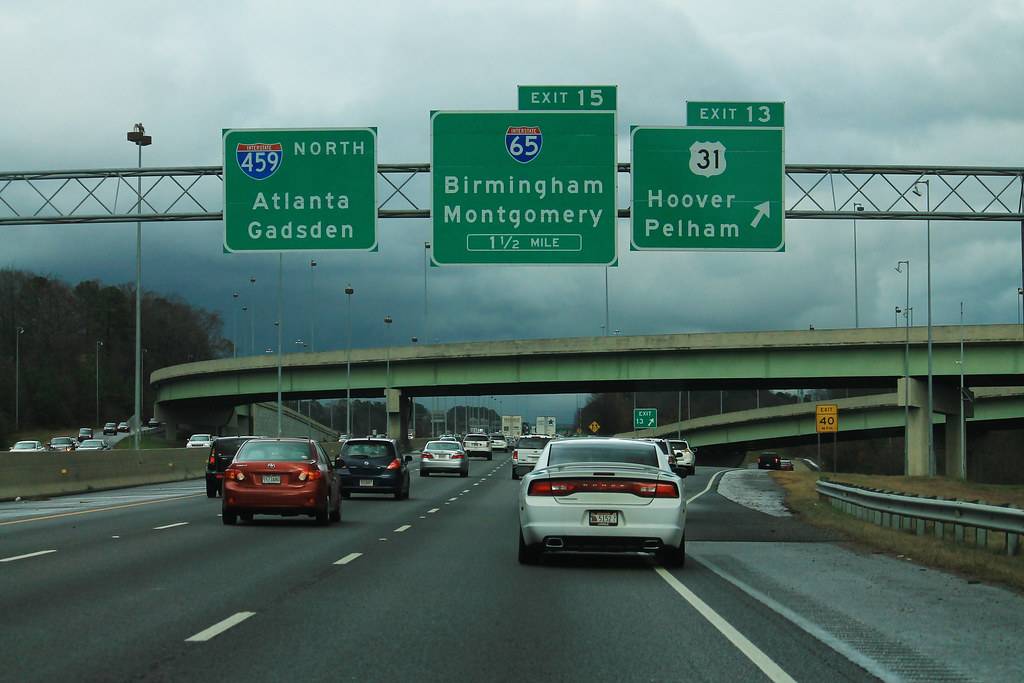
Pelham is a city located in Shelby County, Alabama, and is a suburb of the Birmingham metropolitan area. It was incorporated in July 1964 and was named for Confederate Civil War officer John Pelham. As of the 2020 census, the population of Pelham was 24,318, nearly doubling from the population of 14,369 at the 2000 census.
Pelham is known for its strong sense of community and its commitment to education, offering a number of top-rated schools. The city also offers a variety of recreational opportunities, including parks, trails, and golf courses. Pelham is home to Oak Mountain State Park, which is the largest state park in Alabama and offers a wide range of outdoor activities, including hiking, camping, and fishing. With its convenient location and high quality of life, Pelham is a great place to live, work, and play in the heart of Alabama.
Phoenix City

Phenix City is a city located in Lee and Russell counties in Alabama and is the county seat of Russell County. As of the 2020 Census, the population of the city was 38,817. Phenix City is unique in that it lies immediately west across the Chattahoochee River from Columbus, Georgia, and observes Eastern Time on a de facto basis, in contrast to the rest of Alabama which observes Central Time.
Most of Phenix City is included in the Columbus Metropolitan Statistical Area, and the remainder is in Lee County and therefore included in the Auburn, Alabama Metropolitan Statistical Area. The city is known for its affordability and was named the nation’s No.1 Best Affordable Suburb to raise a family by BusinessWeek in 2007. Phenix City is home to Chattahoochee Valley Community College and a satellite campus of Troy University. In 2020, Eddie N. Lowe was elected as the city’s first black mayor by the public, while Wallace Hunter serves as the city manager.
Prattville

Prattville is a city located within both Autauga and Elmore counties in Alabama and serves as the county seat of Autauga County. As of the 2020 census, the population of the city was 37,781. Prattville is known as “The Fountain City” due to the many artesian wells in the area, which create a number of natural fountains throughout the city.
The city is part of the Montgomery metropolitan statistical area and is known for its strong sense of community and its commitment to education, offering a number of top-rated schools. Prattville also offers a variety of recreational opportunities, including parks, trails, and golf courses. The city’s downtown area features a number of locally-owned businesses and restaurants, making it a vibrant and thriving community. With its convenient location and high quality of life, Prattville is a great place to live, work, and play in the heart of Alabama.
Tuscaloosa
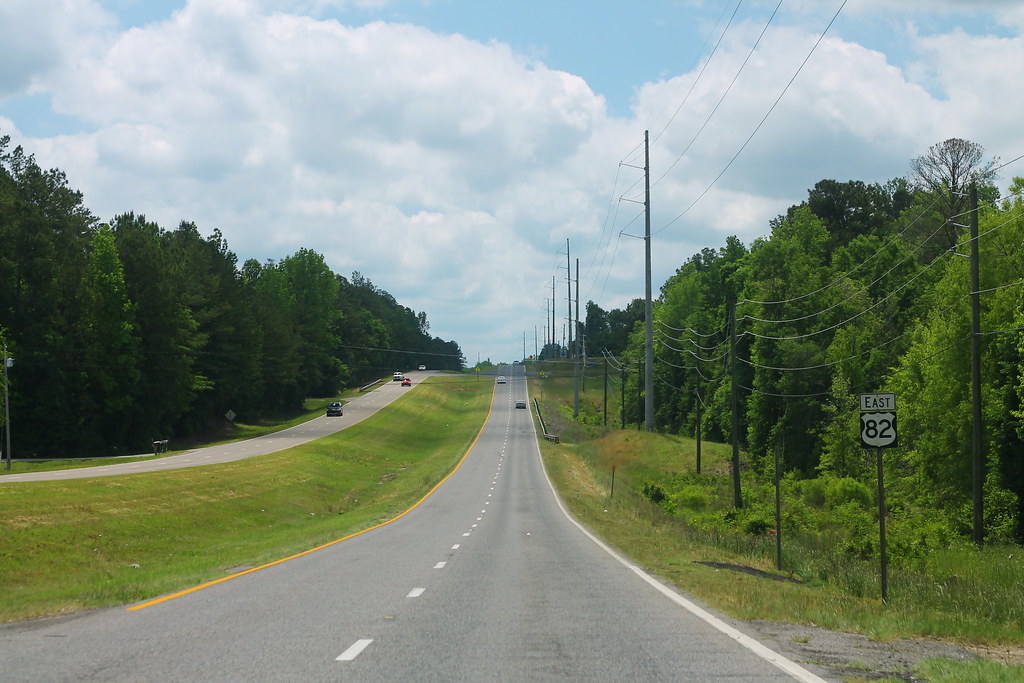
Tuscaloosa is a city located in west-central Alabama and is the seat of Tuscaloosa County. It is known as “the Druid City” due to the numerous water oaks planted in its downtown streets since the 1840s. The city had an estimated population of 102,432 in 2022, making it Alabama’s fifth-most populous city.
Tuscaloosa is the regional center of industry, commerce, healthcare, and education for the area of west-central Alabama known as West Alabama. It is the home of the University of Alabama, Stillman College, and Shelton State Community College, making it a thriving college town. The city also hosted the USA Olympic Triathlon trials for the Beijing Games in 2008.
Tuscaloosa is known for being the former capital of Alabama from 1826 to 1846 before it was moved to its present location in Montgomery. The city is also known as “The City of Champions” after the Alabama Crimson Tide football team won the College Football National Championship in their 2009, 2011, 2012, 2015, 2017, and 2020 seasons. With its rich history and thriving economy, Tuscaloosa is a great place to live, work, and play in the heart of Alabama.
Vestavia Hills

Vestavia Hills, colloquially known as Vestavia, is a city located in Jefferson and Shelby counties in Alabama. It is a suburb of Birmingham and is made up of Vestavia, Liberty Park, and Cahaba Heights. As of the 2020 census, the population of Vestavia Hills was 39,102, up from 34,033 in 2010. The city has grown significantly over the past two decades, moving up from the fifth largest city in Jefferson County in 2000 to the third largest in 2010, behind Birmingham and Hoover.
Vestavia Hills is known for its strong sense of community and its commitment to education, offering a number of top-rated schools. The city also offers a variety of recreational opportunities, including parks, trails, and golf courses. With its convenient location and high quality of life, Vestavia Hills is a great place to live, work, and play in the heart of Alabama.
Interstates
Interstate 59
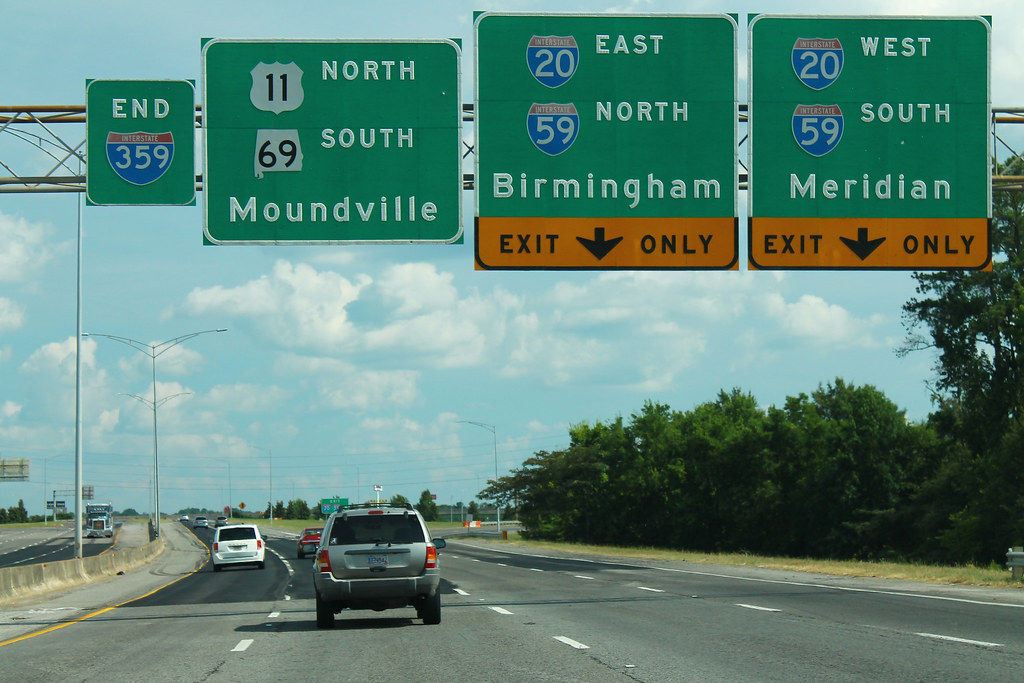
Interstate 59 (I-59) is a north-south route that spans 445.23 miles (716.53 km) from a junction with I-10 and I-12 at Slidell, Louisiana, to a junction with I-24 near Wildwood, Georgia. The highway connects the metropolitan areas of New Orleans, Louisiana; Birmingham, Alabama; and Chattanooga, Tennessee, running closely parallel to the older U.S. Route 11 (US 11) corridor for the entire distance. Approximately one-third of the route, spanning 153 miles (246 km) from Meridian, Mississippi, to Birmingham, Alabama, overlaps that of the east-west I-20.
I-59 is a four-lane freeway along its entire route, other than a short stretch from Tuscaloosa, Alabama to the southern terminus of I-459 and in Birmingham, where it widens to six lanes or more. Despite passing through several metropolitan areas, the I-59 corridor is mainly rural in nature, especially in Georgia.
Interstate 65

Interstate 65 (I-65) is a major highway that spans 366 miles (589 km) across the Alabama countryside, linking six of the state’s 10 largest cities. The highway is a critical link for commerce both within and outside of Alabama, connecting many important roadways.
I-65 starts at I-10 near Mobile and passes through the major cities of Montgomery, Birmingham, and Decatur before entering Tennessee in the north near the town of Ardmore, Alabama. The entire Alabama portion of I-65 is dedicated as Heroes Highway in honor of Central Intelligence Agency officer Johnny Michael Spann and all of the people who died during the September 11 attacks. With its significant role in transportation and commerce, I-65 is a vital part of Alabama’s infrastructure.
Interstate 85

Interstate 85 (I-85) is a part of the Interstate Highway System that runs from Montgomery, Alabama, to Petersburg, Virginia. In Alabama, the highway runs 80 miles (130 km) from I-65 in Montgomery northeast to the Georgia state line near Valley.
Despite being an odd-numbered highway, I-85 travels east-west through the state, serving as the primary highway between Montgomery and Atlanta. The highway also connects Montgomery with Tuskegee, Auburn, Opelika, and indirectly, Phenix City and Columbus, Georgia. With its vital role in connecting major cities and serving as a key transportation route for both commercial and personal travel, I-85 is an essential part of Alabama’s infrastructure.
Interstate 10

Interstate 10 (I-10) is a part of the Interstate Highway System that runs from Santa Monica, California, to Jacksonville, Florida. In Alabama, the highway runs 66.269 miles (106.650 km) from the Mississippi state line near Grand Bay east to the Florida state line at the Perdido River. I-10 serves as the primary east-west highway of the Gulf Coast region of Alabama, connecting Mobile, the largest city in South Alabama, with Pascagoula, Mississippi to the west and Pensacola, Florida to the east.
The highway also connects Mobile and Baldwin County by crossing the northern end of Mobile Bay and the southern end of the Mobile-Tensaw River Delta via the George Wallace Tunnel in Mobile and the Jubilee Parkway viaduct system between Mobile and Daphne. With its strategic location and importance for both commercial and personal travel, I-10 is a critical part of Alabama’s transportation infrastructure.
Interstate 20
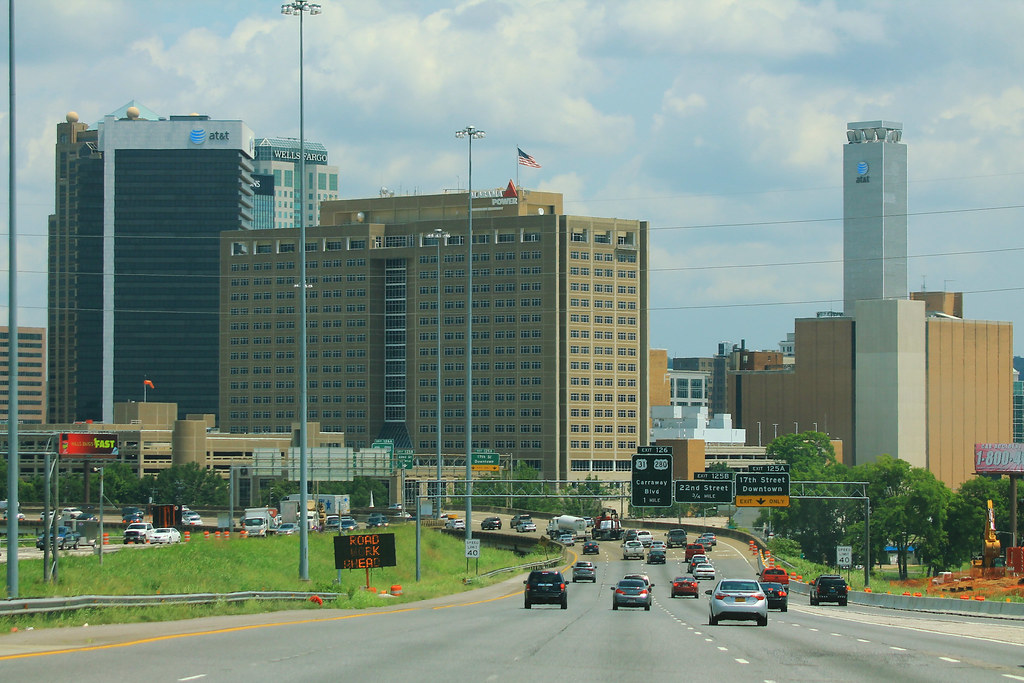
Interstate 20 (I-20) travels 214.7 miles (345.5 km) through the center of Alabama. The highway enters the state from Mississippi near Cuba and travels northeastward through Tuscaloosa and Birmingham. At Birmingham, I-20 turns eastward and heads through Oxford before crossing the Georgia state line near Lebanon. Other cities along the route include Livingston, Bessemer, and Pell City.
For more than half its distance within the state, approximately 130 miles (210 km), I-20 is concurrent with I-59 from the Mississippi state line to eastern Birmingham near Birmingham-Shuttlesworth International Airport. Although both highways have the same mileage for the Alabama concurrency, mileage and exits on the concurrency are I-59’s. With its strategic location and importance for both commercial and personal travel, I-20 is a vital part of Alabama’s transport system.
Highways
Route 11

U.S. Route 11 (US 11) is a major highway that runs southwest to northeast across northcentral Alabama for 250.671 miles (403.416 km). The highway enters the state from Mississippi concurrent with US 80 and exits into Georgia east of Sulphur Springs. US 11 passes through the major cities of Tuscaloosa and Birmingham, as well as the smaller cities and towns of Cuba, York, Livingston, Epes, Boligee, Eutaw, Cottondale, Coaling, Woodstock, Bessemer, Brighton, Midfield, Trussville, Argo, Springville, Ashville, Steele, Attalla, Reece City, and Collinsville.
Although portions of the route are within major cities and towns, US 11 is largely a rural two-lane road. The route has been largely supplanted by Interstate 59 (I-59), as well as I-20 between Mississippi and Birmingham. State Route 7 (SR 7) is designated along the entire route but is unsigned. Despite its decreasing importance in transportation, US 11 remains a significant part of Alabama’s highway system.
Route 29

U.S. Highway 29 (US 29), also known as State Route 15 (SR 15), is a state highway that runs southwest to northeast across the southeastern part of Alabama. US 29 and SR 15 traverse Alabama in a general northeast-southwest slope. While it has never been a major route in the state, US 29 and SR 15 serve primarily to connect numerous smaller towns and cities in the southwest, south-central, and eastern parts of Alabama.
The highway has concurrencies with other routes, including SR 113, SR 3, SR 41, SR 15, SR 55, SR 12, SR 9, SR 10, SR 6, SR 8, and SR 38. US 29 also has concurrencies with U.S Highways including US 31, US 84, US 331, US 82, US 80, and US 280. Despite its decreasing significance in transportation, US 29 remains an important part of Alabama’s highway system.
Route 31
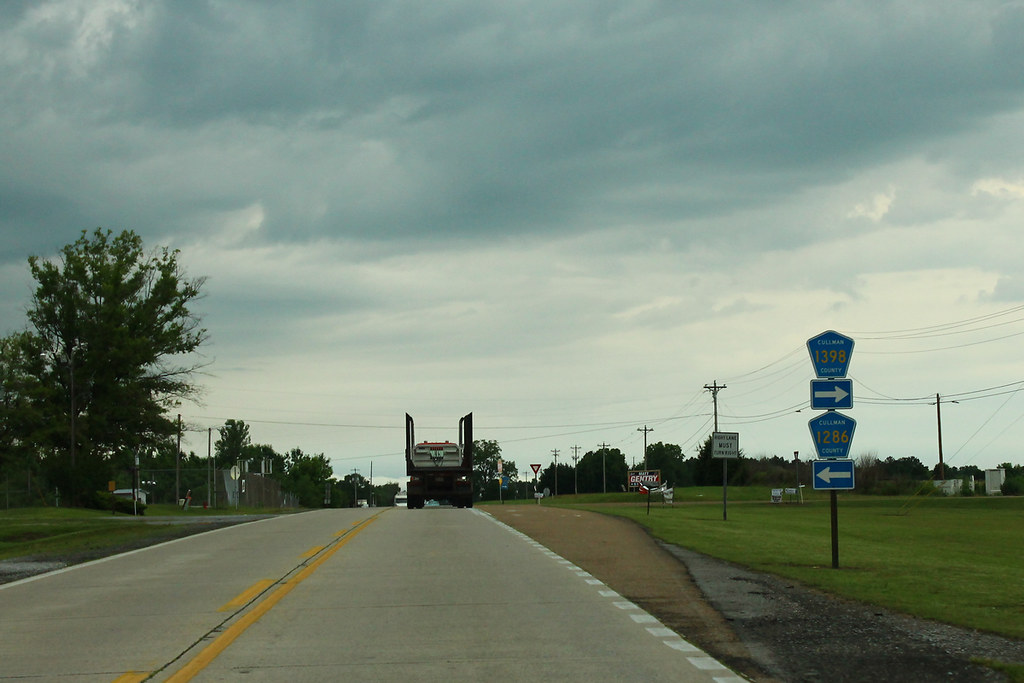
U.S. Route 31 (US 31) is a major highway that runs north-south through the heart of Alabama for 386.449 miles (621.929 km). The highway begins at a junction with US 90 and US 98 in Spanish Fort and exits the state into Tennessee running concurrently with Interstate 65 (I-65) near Ardmore. US 31 passes through the major cities of Montgomery, Birmingham, and Decatur.
Throughout the state, with the exception of its concurrency with I-65 north of Athens, US 31 runs concurrently with the unsigned State Route 3 (SR 3). While portions of the route pass through major towns and cities, US 31 is largely a rural two-lane highway. The highway has been largely supplanted by I-65, with which it has eight junctions and two concurrencies. Despite its decreasing importance in transportation, US 31 remains a significant part of Alabama’s highway system.
Route 43

U.S. Route 43 (US 43) is a 410-mile-long (660 km) north-south United States Highway that travels through the Southern states of Alabama and Tennessee. The highway’s southern terminus is in Prichard, Alabama, at an intersection with US 90, and its northern terminus is in Columbia, Tennessee, at an intersection with US 31/US 412/US 412 Bus. In Alabama and Tennessee, all of the U.S. Highways in each state have one or more unsigned state highways designated along their length.
US 43 travels concurrently with Alabama State Route 13 (SR 13) from its southern terminus to an intersection in southeastern Fayette County. For the rest of its length in the state, US 43 is concurrent with signed state highways. In Tennessee, US 43 travels concurrently with Tennessee State Route 6 (SR 6) along its entire length in the state. The highway also has an unsigned concurrency with SR 227 between Saint Joseph and Loretto. Despite its decreasing significance in transportation, US 43 remains an important part of Alabama’s highway system.
Route 45

U.S. Route 45 (US 45) is a 60-mile-long (97 km) north-south United States Highway in the east-south-central state of Alabama. The highway travels from Mobile to the Mississippi state line, just east of State Line, Mississippi. US 45’s southern terminus is in Mobile, at an intersection with US 98, and its northern terminus in the state of Alabama is at the Mississippi state line. In Alabama, all of the U.S. Highways have one or more unsigned state highways designated along their length.
US 45 travels concurrently with State Route 17 (SR 17) from its southern terminus to just north of Deer Park. For the rest of its length in the state, the highway travels concurrently with State Route 57 (SR 57). Despite its short length in the state, US 45 remains an important part of Alabama’s highway system, connecting Mobile with the neighboring state of Mississippi.
Route 72

U.S. Route 72 (US 72) is an east-west United States highway that travels for 317.811 miles (511.467 km) from southwestern Tennessee, throughout North Mississippi, North Alabama, and southeastern Tennessee. The highway’s western terminus is in Memphis, Tennessee, and its eastern terminus is in Chattanooga. It is the only U.S. Highway to begin and end in the same state, yet pass through other states in between.
While US 72 is the main route, there is also a spur route designated as US 72 Alternate (US 72A) in Alabama. US 72A is a 23.6-mile-long (38.0 km) alternate route of US 72 that bypasses the town of Athens. The highway runs from US 72 west of Athens to US 72 east of Athens. Despite its short length, US 72A serves as an important connector for travelers in the Athens area.
Route 78

U.S. Route 78 (US 78) is a major east-west U.S. Highway that runs across the central part of Alabama. The highway is internally designated as State Route 4 (SR 4) by the Alabama Department of Transportation (ALDOT), although the only section of SR 4 that is signed is along portions mainly west of Jasper.
From the Mississippi state line to near Graysville, US 78 is concurrent with Interstate 22 (I-22). From Graysville south to Birmingham, the highway takes its original routing. However, east of Birmingham to the Georgia state line, US 78 has been replaced as a major through-route by I-20. The two routes roughly parallel each other, with junctions at Leeds and Pell City. West of Jasper, old US 78 is signed as SR 118 to Guin, and the segment from Guin northward to I-22 at Hamilton is signed as US 43/US 278. Despite its decreasing importance in transportation, US 78 remains a significant part of Alabama’s highway system.
Route 80
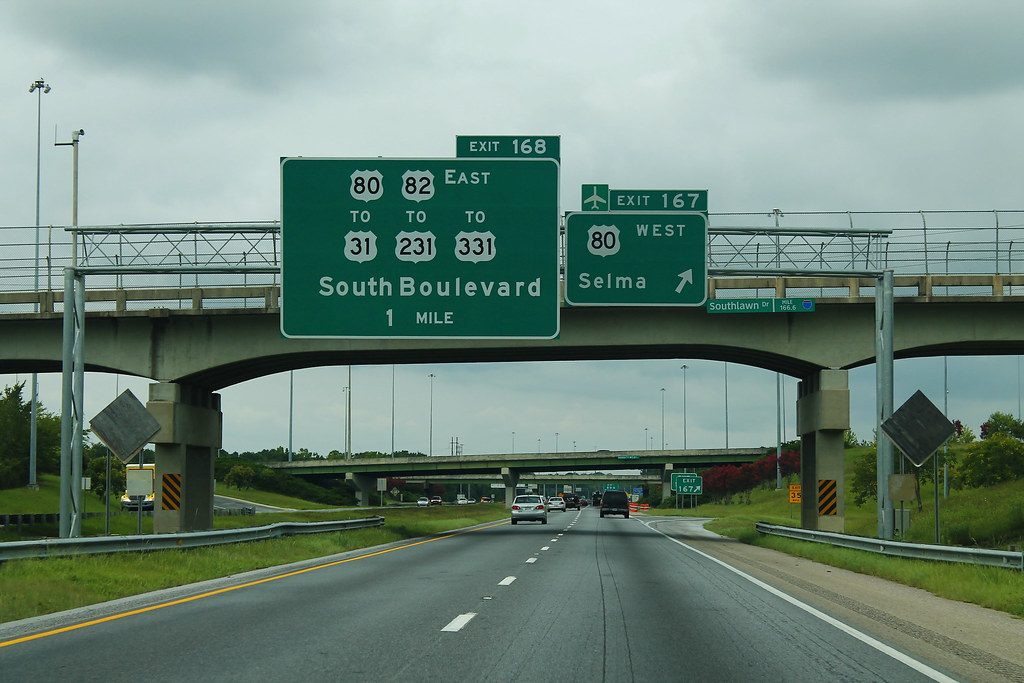
U.S. Route 80 (US 80) is a major U.S. Highway in the American state of Alabama. The Alabama Department of Transportation internally designates the majority of US 80 throughout the state as State Route 8 (SR 8), save for parts of the route throughout Selma and near the Mississippi border.
US 80 serves as the main east-to-west highway through Alabama’s Black Belt region and is historically significant as the main route for the 1965 Selma to Montgomery marches during the Civil Rights Movement. The Edmund Pettus Bridge in Selma was the site of Bloody Sunday, a violent confrontation between marchers and law enforcement that led to the passage of the Voting Rights Act of 1965.
US 80 was also once a major transcontinental highway, known as the Dixie Overland Highway, stretching from Tybee Island, Georgia, to San Diego, California. However, the highway has since been truncated to Dallas, Texas, largely due to the construction of the Interstate Highway System. Despite its decreasing importance in transportation, US 80 remains an important part of Alabama’s highway system and a symbol of the Civil Rights Movement.
Route 82

U.S. Route 82 (US 82) in Alabama runs northwest to southeast across the northwestern and central parts of the state for 240.080 miles (386.371 km). The highway enters Alabama from Mississippi east of Columbus, Mississippi, and exits into Georgia across the Chattahoochee River at Eufaula. US 82 serves as a major transportation route through Alabama, connecting the state with neighboring Mississippi and Georgia.
The highway passes through several major cities, including Tuscaloosa, Montgomery, and Eufaula. Despite its importance in transportation, US 82 has largely been supplanted by the Interstate Highway System, with which it has several junctions and concurrencies. Nevertheless, US 82 remains an important part of Alabama’s highway system, providing a vital connection between the state and its neighboring states.
Route 84

U.S. Route 84 (US 84) in Alabama travels west to east across southern Alabama for 237.400 miles (382.058 km). The highway enters the state from Mississippi west of Silas and exits into Georgia southeast of Gordon. US 84 passes through several towns and cities, including Silas, Coffeeville, Grove Hill, Repton, Evergreen, River Falls, Andalusia, Sanford, Babbie, Opp, Elba, New Brockton, Enterprise, Level Plains, Daleville, Dothan, Cowarts, Avon, and Ashford.
Between Mississippi and River Falls, with the exception of a small segment near Grove Hill, US 84 is largely a rural two-lane road. However, between River Falls and Georgia, the route becomes a major four-lane divided highway connecting major towns of southeastern Alabama. For most of its route through Alabama, excluding a section in Dothan where it is alternatively known as East and West Main Street, US 84 is internally designated by the state of Alabama as State Route 12 (SR 12).
Despite its decreasing importance in transportation, US 84 remains an important part of Alabama’s highway system, connecting the state with its neighboring states and providing a vital link between several towns and cities in southern Alabama.
Route 98
U.S. Route 98 (US 98) is an east-west United States Highway in the Southeastern United States that runs from western Mississippi to southern Florida. Established in 1933 as a route between Pensacola and Apalachicola, Florida, US 98 has since been extended westward into Mississippi and eastward across the Florida Peninsula. The highway runs along much of the Gulf Coast between Mobile, Alabama, and Crystal River, Florida, including extensive sections closely following the coast between Mobile and St. Marks, Florida.
US 98 serves as an important transportation route through Alabama, connecting the state with neighboring Mississippi and Florida. The highway passes through several major cities, including Mobile and Pensacola, and provides access to several popular Gulf Coast tourist destinations. US 98’s western terminus is with US 84 in Bude, Mississippi, and its eastern terminus is Palm Beach, Florida, at State Road A1A (SR A1A) near the Mar-a-Lago resort. Despite its decreasing importance in transportation, US 98 remains an important part of Alabama’s highway system, providing a vital link between the state and its neighboring states.
Route 231

U.S. Route 231 (US 231) in Alabama runs north-south up through the eastern half of Alabama for 306.273 miles (492.899 km). The highway enters the state from Florida south of Madrid and exits into Tennessee, running concurrently with US 431 north of Hazel Green. US 231 passes through several major cities, including Dothan, Troy, Montgomery, and Huntsville.
From the Florida state line to Wetumpka, US 231 is a major four-lane divided thoroughfare that connects Central Alabama to the Florida Gulf Coast and Panama City. Between Wetumpka and Arab, excluding its overlap with US 280 between Sylacauga and Harpersville as well as portions through major towns, the road is largely rural and has two lanes. Nevertheless, the route returns to a four-lane divided highway between Arab and the Tennessee state line, with the section within Huntsville upgraded to a limited-access freeway and adjoining frontage roads named Memorial Parkway.
During its route through the state, US 231 runs concurrently with three state highways, including unsigned State Route 1 (SR 1) between the Florida state line and southern Dothan and between Huntsville and the Alabama state line, SR 53 between northern Dothan and Huntsville, and signed SR 210 while bypassing Dothan. US 231 remains an important part of Alabama’s highway system, connecting the state with its neighboring states and providing access to several major cities and tourist destinations.
Route 278

U.S. Route 278 (US 278) in Alabama, mostly internally designated by the Alabama Department of Transportation as State Route 74 (SR 74), is a major east-west U.S. highway that runs across the northern part of the state. West of Hamilton, SR 74 continues west to end at US 78 (unsigned SR 4), while US 278 turns south along US 43/SR 17/SR 171 to Guin. From Guin, the highway turns west along SR 118 and continues to the Mississippi state line.
US 278 serves as an important transportation route through Alabama, connecting the state with neighboring Mississippi and providing access to several major cities and tourist destinations. The highway passes through several towns and cities, including Hamilton, Fayette, Vernon, and Guin. Despite its decreasing importance in transportation, US 278 remains an important part of Alabama’s highway system, providing a vital link between the state and its neighboring states.
Route 280

U.S. Route 280 (US 280) is a spur of U.S. Highway 80, running for 392 miles (631 km) from Blitchton, Georgia, at US 80 to Birmingham, Alabama at I-20/I-59. The highway travels through rural areas and smaller cities in southern Georgia and east central Alabama for much of its route. However, once the highway approaches Birmingham, it becomes a major suburban route, with numerous shopping centers located on US 280 throughout northern Shelby County and southern Jefferson County.
US 280 is also the main connector between Birmingham and Auburn, Alabama. In Talladega County, Alabama, US 280 is known as the Jim Nabors Highway, in honor of the Sylacauga, Alabama, native known for portraying the television character Gomer Pyle. The historical designation of US-280 and Alabama SR 38 is the Florida Short Route. Despite its decreasing importance in transportation, US 280 remains an important part of Alabama’s highway system, providing a vital link between several cities and towns in central Alabama.
Route 331

U.S. Route 331 (US 331) is a spur of U.S. Route 31, running for 150 miles (240 km) from Santa Rosa Beach, Florida east of Fort Walton Beach at US 98 to Montgomery, Alabama at US 80 and US 82. Unlike US 131, US 231, and US 431, US 331 never intersects with its “parent” route, US 31. However, the two routes do come within 4 miles (6.4 km) of each other in Montgomery.
US 331 serves as an important transportation route through Alabama, connecting the state with neighboring Florida and providing access to several major cities and tourist destinations. The highway passes through several towns and cities, including Montgomery, Luverne, and Opp. Despite its decreasing importance in transportation, US 331 remains an important part of Alabama’s highway system, providing a vital link between the state and its neighboring states.
Route 411

U.S. Route 411 (US 411) is an alternate parallel highway associated with US 11, extending for about 309.7 miles (498.4 km) from US 78 in Leeds, Alabama, to US 25W/US 70 in Newport, Tennessee. The highway travels through northeastern Alabama, northwestern Georgia, and southeastern Tennessee, primarily in a northeast-southwest direction, covering more east-west mileage than north-south.
US 411 passes through several notable towns and cities, including Gadsden, Alabama; Rome, Georgia; Cartersville, Georgia; Maryville, Tennessee; Sevierville, Tennessee, and Newport, Tennessee. Despite never intersecting with US 11, the two routes come very close in various places, including Leeds, Alabama, Gadsden, Alabama, and Maryville, Tennessee.
US 411 also runs close to the Interstate Highway System, including I-20, I-40, I-75, and I-59, though it never has an interchange with I-59. US 411 remains an important part of Alabama’s highway system, providing a vital link between several towns and cities in the northeastern part of the state.
Route 431
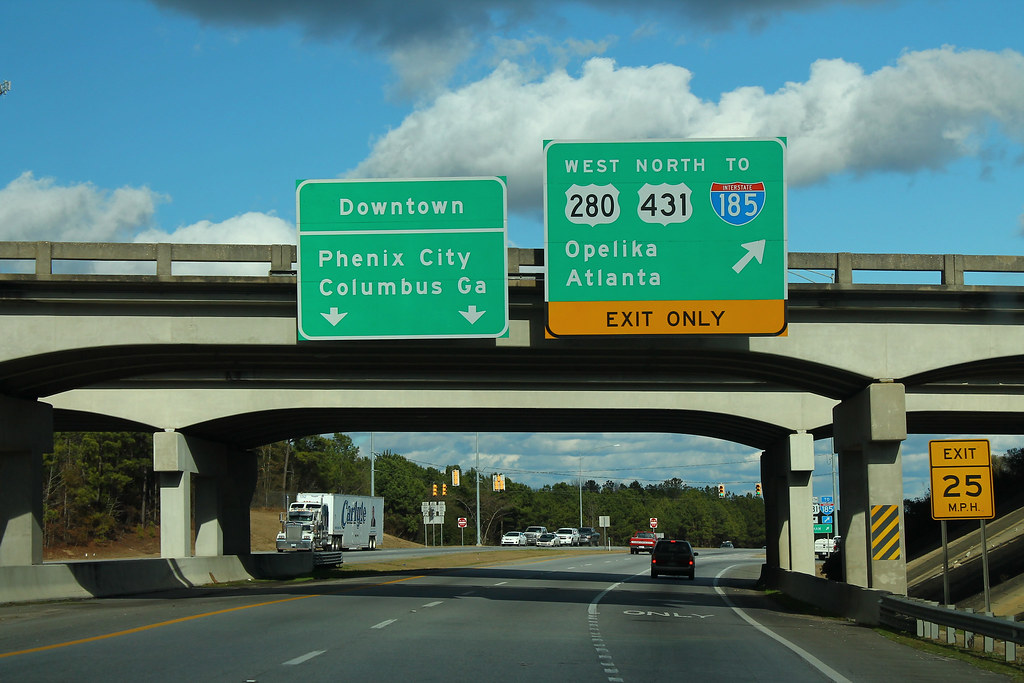
U.S. Route 431 (US 431), internally designated by the Alabama Department of Transportation (ALDOT) as State Route 1 (SR 1), is a major north-south state highway that runs across the eastern part of the U.S. state of Alabama. US 431’s south end is in Dothan, but SR 1 continues south for about 13 miles (21 km) along US 231 to the Florida state line.
US 431 passes through several major cities, including Dothan, Anniston, and Gadsden, and provides access to several popular tourist destinations. The highway is an important transportation route through Alabama, connecting the state with neighboring Georgia and Tennessee. Despite its decreasing importance in transportation, US 431 remains an important part of Alabama’s highway system, providing an essential link between a number of towns and cities in the eastern part of the state.

